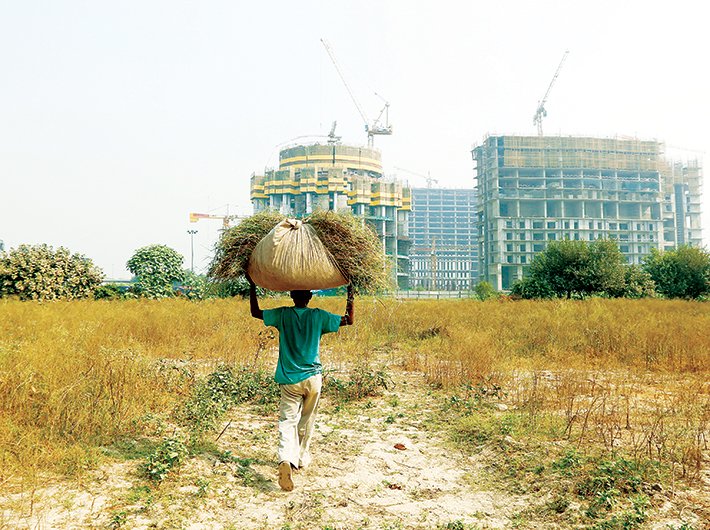Indian cities have been growing exponentially. As modern urban citizens, we give little thought to the dynamics of this expansion. Mainstream thinking focuses on the imperatives of creating cosmopolitan cities. In the post-liberalisation era, governments have given a boost to urban expansion by creating incentives for special economic zones and urban corridors. The growth of outsourcing and information technology sectors has given a new boost to real estate and created a demand for housing and infrastructure. This has created a new generation of modern cities.
Few of us stop to think about who pays the price for this. The rapidly expanding frontiers of the city mean that there is steady encroachment of land and water resources of peripheral areas – often referred as the rural-urban fringe or the peri-urban. Those inhabiting these margins of the city lose resources to support urban expansion.
Most developing nations share common skins – outsized population and nuclear settlements. Cities, towns and villages are closely knit in terms of proximity, barring some exceptions. Therefore, it may not be appropriate to define the boundary of a peri-urban area, especially from a developing country’s perspective. Rather, it is wiser to understand it as a place, marking the geographical space around the city, which is in the process of transition from rural to urban. Conceptually, it helps scholars and policymakers to study rural-urban relationships and the changing flow of resources, goods and services between villages and urban centres.
Cities like Bengaluru, Hyderabad, Gurgaon (now Gurugram) and Chennai have expanded by engulfing the water bodies of the periphery. Traditional water sources like tanks and village ponds, and other common property resources such as grazing lands, have a role in sustaining the livelihoods of landless households and small and marginal farmers. Women collect fodder and fuelwood from such lands, livestock owners use them to rear cattle; washermen and potters depend on ponds for water and silt respectively. Besides, traditional water bodies like the cascading lakes of Hyderabad have an in-built relationship with the ecosystem and help recharge local aquifers. These water bodies have been favoured spots for bird-watchers and ornithologists, attracting a host of resident and migratory birds.
Urbanisation processes implicitly assume that cities need to grow. Implicit biases about urban planning have led to gradual encroachment of resources. They have been acquired by the state to support urban expansion, or encroached upon by real estate and the land mafia. This has had adverse consequence for the livelihoods of those who depended on them.
Much expansion has come from acquiring private lands. While there has been debate on the dynamics and processes of land acquisition, including debates on appropriate compensation for landowners, the worst affected are landless, tenants and sharecroppers. This category of the agrarian population has no basis of being compensated. Besides, most tenancy arrangements are not formally coded; so there would be no basis for claiming compensation.
The current processes of urbanisation and the celebration of the glory of ‘millennium cities’ like Gurgaon mask this inequity inherent in contemporary urbanisation. Urban planning mechanisms pay scant regard to the manner in which the urban shadow falls on these peri-urban spaces. A conventional approach to urban planning and rural development ignores the specific needs of the intermediary spaces between these two extremes and the different ways in which the rural and the urban are related.
How does it matter to us? Are peri-urban spaces of any importance? Urban growth broadly embraces two aspects – first, the growth of the city and second, the source of resources that support such growth. Usually the second half is overlooked as long as we get amenities that we pay for. Seriously! How does it matter? In Gurgaon, the waste runnel that carries the domestic waste of the city serves as a source of irrigation for peri-urban farmers. The crops grown from waste water are chiefly wheat and rice and the yield is sold in the mandis of Delhi and Gurgaon for urban consumption. From the proceeds of the sale of these crops, peri-urban farmers buy food grains for their own use ensuring that they are grown with fresh water. This is not to avenge the tyranny of urbanisation. Instead, this is an act of helplessness of those whose resources have either been over appropriated by the urban elite or acquired by the state or private actors to create equilibrium with the city’s demand.
One may blame the failure of the state to install effective and efficient waste water treatment plants. The population of major cities primarily grows through in-migration, and the existing infrastructure falls short of our expectations in a trice. The majority of the waste water treatment plants face technical glitches or are semi-functional. Bearing in mind the inexplicable rate of increasing waste generation, even if the plants were fully functional, the question would be for how long?
As urbanisation processes advance, the extent and spread of the intermediary spaces between the rural and the urban, that pay the price for this urban expansion, will increase. The current dichotomy between urban planning and rural development will be inadequate to address the growing challenges and complexities of these intermediary spaces. The inequity engendered by these processes creates the need for debate on an alternative paradigm of urbanisation where cities grow within their carrying capacity.
Narain is associate professor, public policy and governance, at Management Development Institute, Gurgaon.
Singh is a student of TERI university.
(The article appears in the March 1-15, 2017 issue of Governance Now)
